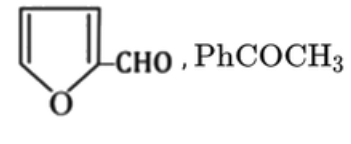Keto-enol tautomerism is observed in :
(i) a.PhCHO , b.PhCOCH3
c. PhCOPh , d. PhCOCH2COCH3
To determine which compounds exhibit keto-enol tautomerism, we need to analyze each compound for the presence of alpha hydrogens. Tautomerism occurs when a compound can exist in two forms: a keto form (with a carbonyl group) and an enol form (with a hydroxyl group adjacent to a double bond). The presence of at least one alpha hydrogen is crucial for this process.
1. Analyze Compound (i): PhCHO (Benzaldehyde)
- Structure: Benzaldehyde has the formula C6H5CHO.
- Alpha Carbon: The carbonyl carbon (C=O) is bonded to a phenyl group (C6H5) and a hydrogen atom.
- Alpha Hydrogen: There are no hydrogens on the carbon adjacent to the carbonyl group (alpha carbon).
- Conclusion: No alpha hydrogen → Does not undergo tautomerism.
2. Analyze Compound (ii): PhCOCH3 (Acetophenone)
- Structure: Acetophenone has the formula C6H5COCH3.
- Alpha Carbon: The carbon adjacent to the carbonyl group is a methyl group (CH3).
- Alpha Hydrogen: The methyl group has three alpha hydrogens.
- Conclusion: Presence of alpha hydrogens → Undergoes tautomerism.
3. Analyze Compound (iii): PhCOPh (Benzophenone)
- Structure: Benzophenone has the formula C6H5COC6H5.
- Alpha Carbons: There are two phenyl groups attached to the carbonyl carbon.
- Alpha Hydrogen: Neither of the alpha carbons has any hydrogens.
- Conclusion: No alpha hydrogen → Does not undergo tautomerism.
4. Analyze Compound (iv): PhCOCH2COCH3 (4-Hydroxy-3-pentanone)
- Structure: This compound has a carbonyl group with two adjacent carbons (one being CH2 and the other being CH3).
- Alpha Carbons: There are two alpha carbons (one CH2 and one CH3).
- Alpha Hydrogen: Both of these carbons have alpha hydrogens (the CH2 has two and the CH3 has three).
- Conclusion: Presence of alpha hydrogens → Undergoes tautomerism.
Final Answer:
- The compounds that exhibit keto-enol tautomerism are:
- (ii) PhCOCH3 (Acetophenone)
- (iv) PhCOCH2COCH3 (4-Hydroxy-3-pentanone)
- Structure: Benzaldehyde has the formula C6H5CHO.
- Alpha Carbon: The carbonyl carbon (C=O) is bonded to a phenyl group (C6H5) and a hydrogen atom.
- Alpha Hydrogen: There are no hydrogens on the carbon adjacent to the carbonyl group (alpha carbon).
- Conclusion: No alpha hydrogen → Does not undergo tautomerism.
- Structure: Acetophenone has the formula C6H5COCH3.
- Alpha Carbon: The carbon adjacent to the carbonyl group is a methyl group (CH3).
- Alpha Hydrogen: The methyl group has three alpha hydrogens.
- Conclusion: Presence of alpha hydrogens → Undergoes tautomerism.
- Structure: Benzophenone has the formula C6H5COC6H5.
- Alpha Carbons: There are two phenyl groups attached to the carbonyl carbon.
- Alpha Hydrogen: Neither of the alpha carbons has any hydrogens.
- Conclusion: No alpha hydrogen → Does not undergo tautomerism.
- Structure: This compound has a carbonyl group with two adjacent carbons (one being CH2 and the other being CH3).
- Alpha Carbons: There are two alpha carbons (one CH2 and one CH3).
- Alpha Hydrogen: Both of these carbons have alpha hydrogens (the CH2 has two and the CH3 has three).
- Conclusion: Presence of alpha hydrogens → Undergoes tautomerism.
- The compounds that exhibit keto-enol tautomerism are:
- (ii) PhCOCH3 (Acetophenone)
- (iv) PhCOCH2COCH3 (4-Hydroxy-3-pentanone)
Topper's Solved these Questions
- ISOMERISMBook:CENGAGE CHEMISTRY ENGLISHChapter:ISOMERISMExercise:Example
Explore 15 Videos
- ISOMERISMBook:CENGAGE CHEMISTRY ENGLISHChapter:ISOMERISMExercise:Exercise
Explore 19 Videos
- IONIC EQUILIBRIUMBook:CENGAGE CHEMISTRY ENGLISHChapter:IONIC EQUILIBRIUMExercise:Archives Subjective
Explore 28 Videos
- NCERT BASED EXERCISEBook:CENGAGE CHEMISTRY ENGLISHChapter:NCERT BASED EXERCISEExercise:Chemical Equilibrium
Explore 73 Videos
Similar Questions
Keto enol tautomerism is not observed in:
View SolutionWrite the IUPAC name of CH3COCH2COCH3.
View SolutionWrite the IUPAC name of CH3COCH2COCH3.
View SolutionWrite the IUPAC name of CH3COCH2COCH3.
View SolutionHow many of these compounds can undergo cannizzaro reaction here
CH3CHO,CH3COCH3,HCHO,Ph−CHO,Ph−CO−CHO, , PhCOCH3
, PhCOCH3
View SolutionIdentify the electrophile center in the following :
(i) CH3CHO (ii) CH3CH=CH2 (iii) CH3COCH3
View SolutionWrite the IUPAC name of : CH3CH2COCH3.
View SolutionGive the IUPAC name of the following :
(i) HCHO
(ii) CH3COCH3
View SolutionWrite IUPAC name of the compound : CH3COCH2COCH3.
View SolutionWrite IUPAC name of the compound : CH3COCH2COCH3.
View Solution